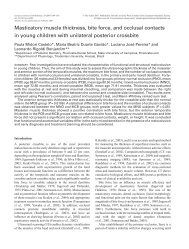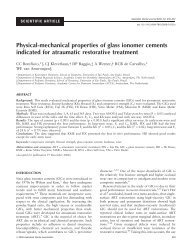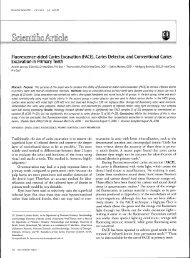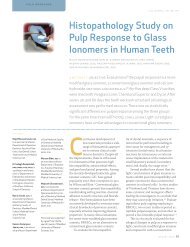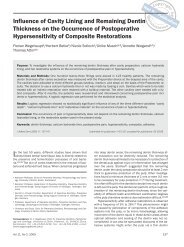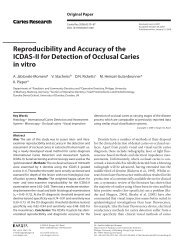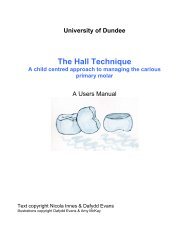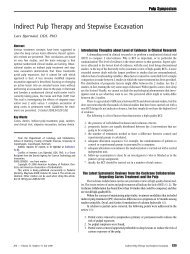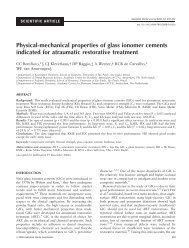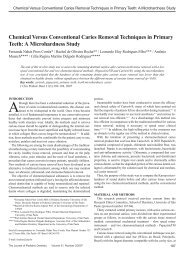Pit and Fissure Sealants in the Prevention of Dental Caries in ...
Pit and Fissure Sealants in the Prevention of Dental Caries in ...
Pit and Fissure Sealants in the Prevention of Dental Caries in ...
Create successful ePaper yourself
Turn your PDF publications into a flip-book with our unique Google optimized e-Paper software.
––– <strong>Sealants</strong>: <strong>Prevention</strong> <strong>of</strong> <strong>Caries</strong> –––<br />
Citation: Yildiz E, Dorter C, Efes B, Koray F. A comparative study <strong>of</strong> two fissure sealants: a 2-year cl<strong>in</strong>ical follow-up.<br />
J Oral Rehabil 2004; 31(10):979–84.<br />
Material: Fluoride-conta<strong>in</strong><strong>in</strong>g Helioseal F fissure sealant, <strong>and</strong> conventional Concise Light Cure White Sealant fissure<br />
sealant<br />
Selection <strong>of</strong> Teeth <strong>and</strong> Tooth Type or Morphology: First <strong>and</strong> second permanent molars<br />
Technique:<br />
1. Use cotton wool rolls for isolation, along with a flexible plastic saliva ejector.<br />
2. Clean <strong>the</strong> tooth with a prophylaxis brush us<strong>in</strong>g nonfluoridated pumice.<br />
3. R<strong>in</strong>se, <strong>the</strong>n dry.<br />
4. Etch, r<strong>in</strong>se with water for 20 seconds, <strong>the</strong>n dry with air blast (until tooth has chalky, frosted appearance).<br />
5. Apply fissure sealant materials accord<strong>in</strong>g to manufacturer’s <strong>in</strong>structions.<br />
6. Cure for 40 seconds with Coltolux 4 (Colténe, CH 9450, Switzerl<strong>and</strong>) dental cur<strong>in</strong>g light.<br />
7. No repair or replacement <strong>of</strong> <strong>in</strong>sufficient sealants.<br />
Citation : Pardi V, Pereira AC, Mialhe FL, Meneghim Mde C, Ambrosano GM. A 5-year evaluation <strong>of</strong> two glassionomer<br />
cements used as fissure sealants. Community Dent Oral Epidemiol 2003; 31(5):386–91.<br />
Material: Vitremer res<strong>in</strong>-modified glass ionomer cement (3M ESPE, St Paul, M<strong>in</strong>n.) <strong>and</strong> Ketac-Bond conventional<br />
glass ionomer cement (3M ESPE)<br />
Selection <strong>of</strong> Teeth <strong>and</strong> Tooth Type or Morphology: Permanent first molars<br />
Technique:<br />
1. Pumice prophylaxis <strong>of</strong> <strong>the</strong> occlusal surfaces<br />
2. Cotton roll isolation<br />
3. 30 seconds condition<strong>in</strong>g with 35% phosphoric acid gel<br />
4. Wash, cotton roll substitution<br />
Vitremer application:<br />
1. Primer application for 30 seconds<br />
2. Air-dry<strong>in</strong>g <strong>and</strong> light-cur<strong>in</strong>g for 20 seconds<br />
3. Mix<strong>in</strong>g <strong>of</strong> material <strong>in</strong> a 1:2 powder–liquid ratio, to obta<strong>in</strong> lower viscosity so that <strong>the</strong> mixture flows <strong>in</strong>to <strong>the</strong> fissures<br />
4. Insertion <strong>of</strong> material <strong>in</strong>to fissures with an explorer, along <strong>the</strong> entire extension<br />
5. Light-cur<strong>in</strong>g for 40 seconds<br />
6. Application <strong>of</strong> “F<strong>in</strong>ish<strong>in</strong>g Gloss” followed by light-cur<strong>in</strong>g for 20 seconds<br />
7. Verification <strong>and</strong> adjustment <strong>of</strong> occlusal contacts when necessary<br />
Ketac-Bond application:<br />
1. Mix<strong>in</strong>g <strong>of</strong> material <strong>in</strong> a 1:1 powder–liquid ratio, to obta<strong>in</strong> a lut<strong>in</strong>g consistency<br />
2. Insertion <strong>of</strong> material <strong>in</strong>to fissures with an explorer, along <strong>the</strong> entire extension<br />
3. 5-m<strong>in</strong>ute wait for <strong>in</strong>itial cur<strong>in</strong>g mechanism<br />
4. Material covered with unfilled res<strong>in</strong> to ma<strong>in</strong>ta<strong>in</strong> moisture balance<br />
5. Check<strong>in</strong>g <strong>and</strong> adjustment <strong>of</strong> occlusal contacts when necessary<br />
JCDA • www.cda-adc.ca/jcda • March 2008, Vol. 74, No. 2 • App_183xxxv





